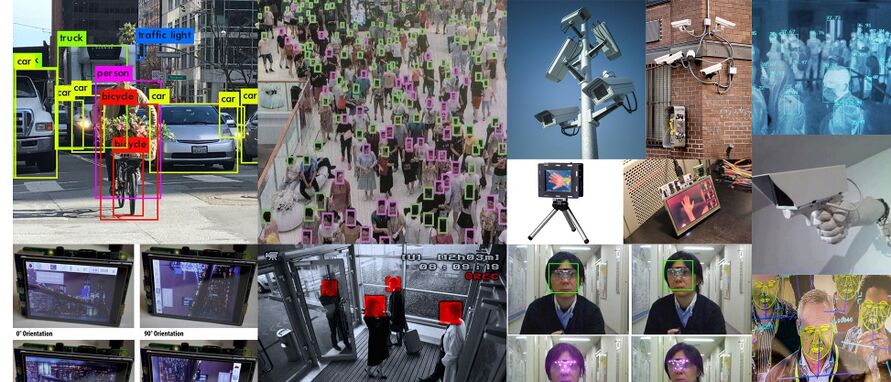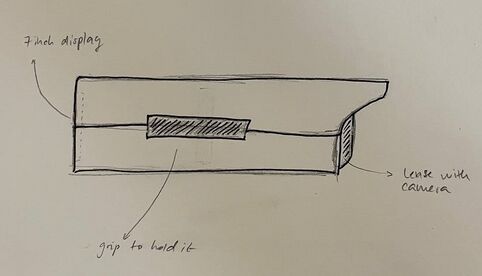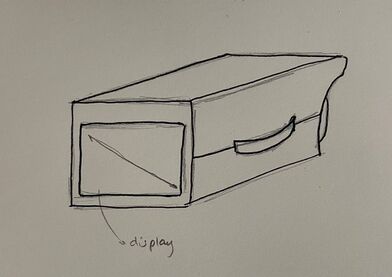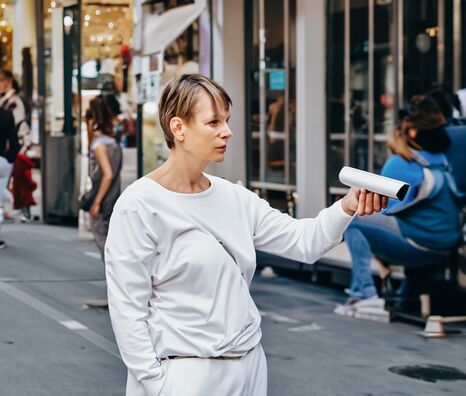User:Berna Bereit Project That May or May Not Be Made: Difference between revisions
Berna Bereit (talk | contribs) No edit summary |
Berna Bereit (talk | contribs) |
||
| (5 intermediate revisions by the same user not shown) | |||
| Line 6: | Line 6: | ||
== re-secure == | == re-secure == | ||
In the modern urban landscape, surveillance systems are ubiquitously presented as essential components of comprehensive security infrastructures. These systems, comprising numerous discreet cameras and sensors, are designed to blend seamlessly into the cityscape, yet they harbor sophisticated capabilities for data collection and monitoring. Despite the proliferation of such surveillance technologies over the past two decades, a significant portion of the population, particularly women, continues to feel unsafe in public and semi-private spaces, especially after dark. | |||
For instance, in cities like Amsterdam and Rotterdam, extensive CCTV networks have been installed to enhance public safety. However, statistics reveal a persistent feeling of insecurity among women. Approximately 43% of women in Amsterdam and 39% in Rotterdam report feeling unsafe walking alone at night (Municipal Safety Report 2023). This discrepancy between the presence of surveillance and the subjective feeling of security raises critical questions about the effectiveness and purpose of these systems. | |||
=== Project Aim === | |||
The "re-secure" installation aims to explore these issues by using design as a medium to unveil the realities of surveillance and prompt critical reflection on security in urban environments. The project consists of an aesthetically seamless surveillance camera that allows users to assume the role of the observer, thereby reversing the traditional dynamic of surveillance. Through this installation, users can access live transmissions from surveillance cameras located throughout the city, processed into a compelling video narrative. | |||
=== | === Concept and Design === | ||
The "re-secure" installation features a 3.2GHz receiver that captures signals from various city surveillance cameras. Users peer through the camera's eyepiece to view a 5-inch LCD display, where they watch a short video composed of footage from hacked surveillance cameras. The video consistently shows the same person monitoring themselves for their own safety, emphasizing the personal dimension of (in)security and offering a critical perspective on the role of surveillance systems. | |||
The | === Narrative and Interaction === | ||
This installation challenges the traditional narrative of surveillance by empowering women to monitor their own safety. By shifting the locus of control, it questions for whom security cameras are truly designed and whose security they aim to guarantee. The narrative concludes by encouraging viewers to reflect on their own sense of security and the implications of being surveilled. | |||
=== Feminist Perspectives === | |||
The project draws inspiration from feminist practices and literature, such as the work "Why Loiter?" by Phadke, S., Khan, S., & Ranade, S. (2011). This text explores the complex dynamics of women's presence in public spaces and critiques the patriarchal structures that restrict their mobility under the guise of protectionism. Similarly, "re-secure" aims to highlight the limitations of current surveillance systems in truly ensuring personal security and to promote collective self-empowerment as a response to these limitations. | |||
=== Conclusion === | |||
"re-secure" invites users to critically engage with the pervasive yet often opaque nature of urban surveillance. It serves as a tool for reflection and dialogue, questioning the effectiveness of surveillance in enhancing personal security and advocating for a more inclusive and equitable approach to public safety. | |||
=== Timetable === | === Timetable === | ||
| Line 39: | Line 43: | ||
=== Previous practice === | === Previous practice === | ||
Surveillance cameras have become part of our everyday cityscape. Yet the small devices are usually very inconspicuous. The consequences can be all the more serious, as a current example from Saxony, Germany shows: a new police law was passed in 2019. The use of video surveillance with biometric facial recognition by the state police within a 30-km radius of the Saxon federal border has put almost half of the entire State under surveillance, leading to an outcry and a lawsuit. | |||
The pixel glasses make a contribution to self-determined technological use in the style of already existing projects. For example, the pixel glasses protect against involuntary facial recognition by surveillance cameras. This becomes particularly significant in activist operations. Taking the example of protests in Hong Kong (2019), one can see that activists could be recorded by cameras and assigned by AI. The pixel glasses support political engagement and prevent suppression of different opinions, piracy for privacy. | |||
Find out more about the project here: <nowiki>http://bernadettegeiger.com/working_with_against_technology.html</nowiki> | |||
=== Installation === | |||
The object will be an interactive installation. Visitors can take the security camera and view the video in the inside of the case. A pair of headphones can also be plugged in to listen to the video, additionally subtitles will be displayed in the video. | |||
=== Relation to a wider context === | === Relation to a wider context === | ||
| Line 53: | Line 64: | ||
=== Additional Reference === | === Additional Reference === | ||
==== Simone C. Niquille ==== | |||
[<nowiki>https://www.wired.com/2013/10/thwart-facebooks-creepy-auto-tagging-with-these-bizarre-t-shirts/</nowiki>] | |||
The artist Simone C. Niquille developed a series of anti-face recognition objects as part of her graduation project (2013) at the Sandberg Institute Amsterdam. Her work was based on the Facebook algorithm, which can recognise faces in images and then makes suggestions for people's markings. Her three projects are presented below: | |||
'''''FaceValue''''' | |||
FaceValue is an exploration of the history and significance of the human face as an interface and its new value in the age of facial recognition technology. | |||
'''''Realface Glamouflage''''' | |||
"REALFACE Glamouflage" is a T-shirt collection printed with patterns of the faces of famous people such as Michael Jackson, Britney Spears and Barack Obama. This is intended to prevent facial recognition algorithms from recognising people. | |||
'''''Facebay''''' | |||
Facebay is a library for new face options. It provides users with a selection of other people's faces. But you can also use and manipulate your own face (vgl. Leonardy 2013). | |||
==== Data Masks Series ==== | |||
The Data Masks Series project by Sterling Crispin (2014) takes a critical look at the aggressive over-development of surveillance technologies and how they are changing human identity and the interaction between humans and technology. The term technology here refers to individual devices and networked systems such as cameras and software. He works with the technique of reverse engineering facial recognition and image correlation techniques. The results of the research are various 3D-printed masks that have been developed algorithmically. The aim of the project is not to avoid facial recognition technologies, but rather to show the machine what it is looking for. To hold up a mirror to it, so to speak. The masks are used for protest actions, poetry and civil disobedience (vgl. Crispin 2014). | |||
==== CV Dazzle ==== | |||
CV Dazzle, a project by artist Adam Harvey, explores the possibilities of camouflaging oneself from machine facial recognition by styling hair and make-up. The project sees itself as a development of strategies and concepts, whereby each design is individually tailored to algorithms and faces. The aim is to encourage people to develop and wear their own looks. The images shown here serve as a template and inspiration (vgl. Harvey 2010). | |||
==== Reflectacles ==== | |||
[https://www.reflectacles.com/<nowiki>]</nowiki> | |||
Reflectacles are glasses specifically designed to trick facial recognition systems. They can be used against infrared as well as systems that use 3D infrared mapping/scanning. Two analogue techniques are used for this purpose: infrared-blocking lenses on the one hand and reflective frames on the other (vgl. Urban Spectacles 2022). | |||
==== Further projects: ==== | |||
* Iris van Herpen | |||
* Jing-Cai Liu’s Wearable Face Projector (2017) | |||
* Jip van Leeuwenstein’s Surveillance Exclusion Mask | |||
* Ewa Nowak’s INCOGNITO mask | |||
* <nowiki>https://qz.com/10-fashions-to-help-you-confuse-facial-recognition-syst-1851112545</nowiki> | * <nowiki>https://qz.com/10-fashions-to-help-you-confuse-facial-recognition-syst-1851112545</nowiki> | ||
* <nowiki>https://www.businessinsider.nl/clothes-accessories-that-outsmart-facial-recognition-tech-2019-10?international=true&r=US</nowiki> | * <nowiki>https://www.businessinsider.nl/clothes-accessories-that-outsmart-facial-recognition-tech-2019-10?international=true&r=US</nowiki> | ||
| Line 62: | Line 107: | ||
=== Sources === | === Sources === | ||
Crispin, Sterling (2014): Data Masks Series. Online. URL: <nowiki>http://www.sterlingcrispin.com/data-masks.html</nowiki> | |||
Deutsches Hygiene Museum Dresden (DHMD) (2022): FAKE Die ganze Wahrheit. Eine Ausstellung in Kooperation mit dem Stapferhaus (CH) kuratiert von Daniel Tyradellis. Die dazugehörige Website: <nowiki>https://www.dhmd.de/ausstellungen/vorschau/fake</nowiki> | |||
Forbes (2021): HERR DER SINNE. In: Forbes. Online. URL: <nowiki>https://www.forbes.at/artikel/herr-der-sinne.html</nowiki> | |||
Frankfurter Allgemeine (faz) (2015): Smarte Socken und elektronische Tattoos. Online. URL: <nowiki>https://www.faz.net/aktuell/wirtschaft/netzwirtschaft/zukunft-der-wearables-smarte-socken-und-elektronische-tattoos-13926968.html</nowiki> | |||
Genzmer, Jenny und Ufer, Gesa (2020): Jenseits von Siri und Alexa. In: Deutschlandfunk Kultur. Online. URL: <nowiki>https://www.deutschlandfunkkultur.de/cyberfeminismus-jenseits-von-siri-und-alexa-100.html</nowiki> | |||
Gesellschaft für Freiheitsrechte e.V. (2020). Online. URL: <nowiki>https://freiheitsrechte.org/</nowiki> | |||
Grumbach, Detlef (2016): Wenn Mensch und Maschine verschmelzen. In: Deutschlandfunk. Online. URL: <nowiki>https://www.deutschlandfunk.de/kybernetik-wenn-mensch-und-maschine-verschmelzen-100.html</nowiki> | |||
Haraway, Donna (1985.): Manifesto for Cyborgs: Science, Technology, and Socialist Feminism in the 1980‘s. In: Socialist Review 80. S. 65-108. | |||
Harvey, Adam (2010): Computer Vision Dazzle Camouflage. Online. URL: <nowiki>https://cvdazzle.com/</nowiki> | |||
Leonardy, Ross (2013): FACEVALUE by SIMONE NIQUILLE. In: O FLUXO. Online. URL: <nowiki>https://www.ofluxo.net/facevalue-by-simone-niquille/</nowiki> | |||
Lordick, Marina (2016): Transhumanismus: Die Cyborgisierung des Menschen. In: zukunftsInstitut. Online: URL: <nowiki>https://www.zukunftsinstitut.de/artikel/transhumanismus-die-cyborgisierung-des-menschen/</nowiki> | |||
Mareis, Claudia: Unsichtbares Design und post-optimale Objekte. Interfacedesign und Entmaterialisierungsdiskurse seit circa 1960. In: Bartz, Christina;Kaerlein, Timo;Miggelbrink, Monique;Neubert, Christoph: Gehäuse: Mediale Einkapselungen. Paderborn: Fink 2019, S. 93-114. DOI: 10.25969/mediarep/3961. | |||
Meyer, Bertolt (2020). Der DJ mit der musikalischen Armprothese. In: Deutschlandfunk. Online. URL: <nowiki>https://www.deutschlandfunkkultur.de/psychologe-bertolt-meyer-der-dj-mit-der-musikalischen-100.html</nowiki> | |||
M. Eifler (2020): Prosthetic Memory. In: Ars Electronica. Online. URL: <nowiki>https://starts-prize.aec.at/de/prosthetic-memory/</nowiki> | |||
Schacht, Marie (2010): Natürliche Interaktion mit Tangible User Interfaces. In: TU Dresden. Online. URL: <nowiki>https://tu-dresden.de/ing/informatik/smt/mg/ressourcen/dateien/studentische-arbeiten/2010_Beleg_Schacht.pdf?lang=de</nowiki> | |||
Urban Spectacles (2022): Reflectacles. Chicago. Online. URL: <nowiki>https://www.reflectacles.com/creator-info</nowiki> | |||
Latest revision as of 10:55, 14 June 2024
These proposals originally were developed in this pad, but not all of them made it to the wiki page: https://pad.xpub.nl/p/bernadette-geiger-t3-methods. The accompanied research and developing process done for this project can be read here: https://pad.xpub.nl/p/bernadette-geiger-re-observer
Here you can find the content of the project itself: https://pad.xpub.nl/p/bernadette-geiger-re-secure-content
Explore other May or May Not Be Made Projects here: RapidPrototypeandProject that May
re-secure
In the modern urban landscape, surveillance systems are ubiquitously presented as essential components of comprehensive security infrastructures. These systems, comprising numerous discreet cameras and sensors, are designed to blend seamlessly into the cityscape, yet they harbor sophisticated capabilities for data collection and monitoring. Despite the proliferation of such surveillance technologies over the past two decades, a significant portion of the population, particularly women, continues to feel unsafe in public and semi-private spaces, especially after dark.
For instance, in cities like Amsterdam and Rotterdam, extensive CCTV networks have been installed to enhance public safety. However, statistics reveal a persistent feeling of insecurity among women. Approximately 43% of women in Amsterdam and 39% in Rotterdam report feeling unsafe walking alone at night (Municipal Safety Report 2023). This discrepancy between the presence of surveillance and the subjective feeling of security raises critical questions about the effectiveness and purpose of these systems.
Project Aim
The "re-secure" installation aims to explore these issues by using design as a medium to unveil the realities of surveillance and prompt critical reflection on security in urban environments. The project consists of an aesthetically seamless surveillance camera that allows users to assume the role of the observer, thereby reversing the traditional dynamic of surveillance. Through this installation, users can access live transmissions from surveillance cameras located throughout the city, processed into a compelling video narrative.
Concept and Design
The "re-secure" installation features a 3.2GHz receiver that captures signals from various city surveillance cameras. Users peer through the camera's eyepiece to view a 5-inch LCD display, where they watch a short video composed of footage from hacked surveillance cameras. The video consistently shows the same person monitoring themselves for their own safety, emphasizing the personal dimension of (in)security and offering a critical perspective on the role of surveillance systems.
Narrative and Interaction
This installation challenges the traditional narrative of surveillance by empowering women to monitor their own safety. By shifting the locus of control, it questions for whom security cameras are truly designed and whose security they aim to guarantee. The narrative concludes by encouraging viewers to reflect on their own sense of security and the implications of being surveilled.
Feminist Perspectives
The project draws inspiration from feminist practices and literature, such as the work "Why Loiter?" by Phadke, S., Khan, S., & Ranade, S. (2011). This text explores the complex dynamics of women's presence in public spaces and critiques the patriarchal structures that restrict their mobility under the guise of protectionism. Similarly, "re-secure" aims to highlight the limitations of current surveillance systems in truly ensuring personal security and to promote collective self-empowerment as a response to these limitations.
Conclusion
"re-secure" invites users to critically engage with the pervasive yet often opaque nature of urban surveillance. It serves as a tool for reflection and dialogue, questioning the effectiveness of surveillance in enhancing personal security and advocating for a more inclusive and equitable approach to public safety.
Timetable
15.05 - 20.05: fully formulate concept + references/sources
21.05 - 28.05: think of technical aspects - How could it be built? What compontents do I need? Sketches for help
28.05: List for ordering electronics
29.05 - 05.06: Close primary research
05.06 - 19.06: production of product
20.06: testing
21.06 - 26.06: final changes + set up for SI24 lauch
27.06: SI24 launch built up
Previous practice
Surveillance cameras have become part of our everyday cityscape. Yet the small devices are usually very inconspicuous. The consequences can be all the more serious, as a current example from Saxony, Germany shows: a new police law was passed in 2019. The use of video surveillance with biometric facial recognition by the state police within a 30-km radius of the Saxon federal border has put almost half of the entire State under surveillance, leading to an outcry and a lawsuit.
The pixel glasses make a contribution to self-determined technological use in the style of already existing projects. For example, the pixel glasses protect against involuntary facial recognition by surveillance cameras. This becomes particularly significant in activist operations. Taking the example of protests in Hong Kong (2019), one can see that activists could be recorded by cameras and assigned by AI. The pixel glasses support political engagement and prevent suppression of different opinions, piracy for privacy.
Find out more about the project here: http://bernadettegeiger.com/working_with_against_technology.html
Installation
The object will be an interactive installation. Visitors can take the security camera and view the video in the inside of the case. A pair of headphones can also be plugged in to listen to the video, additionally subtitles will be displayed in the video.
Relation to a wider context
#antisurveillance #cctv #piracyforprivacy #whatismydataworth
Rapid prototype template
Additional Reference
Simone C. Niquille
[https://www.wired.com/2013/10/thwart-facebooks-creepy-auto-tagging-with-these-bizarre-t-shirts/]
The artist Simone C. Niquille developed a series of anti-face recognition objects as part of her graduation project (2013) at the Sandberg Institute Amsterdam. Her work was based on the Facebook algorithm, which can recognise faces in images and then makes suggestions for people's markings. Her three projects are presented below:
FaceValue
FaceValue is an exploration of the history and significance of the human face as an interface and its new value in the age of facial recognition technology.
Realface Glamouflage
"REALFACE Glamouflage" is a T-shirt collection printed with patterns of the faces of famous people such as Michael Jackson, Britney Spears and Barack Obama. This is intended to prevent facial recognition algorithms from recognising people.
Facebay
Facebay is a library for new face options. It provides users with a selection of other people's faces. But you can also use and manipulate your own face (vgl. Leonardy 2013).
Data Masks Series
The Data Masks Series project by Sterling Crispin (2014) takes a critical look at the aggressive over-development of surveillance technologies and how they are changing human identity and the interaction between humans and technology. The term technology here refers to individual devices and networked systems such as cameras and software. He works with the technique of reverse engineering facial recognition and image correlation techniques. The results of the research are various 3D-printed masks that have been developed algorithmically. The aim of the project is not to avoid facial recognition technologies, but rather to show the machine what it is looking for. To hold up a mirror to it, so to speak. The masks are used for protest actions, poetry and civil disobedience (vgl. Crispin 2014).
CV Dazzle
CV Dazzle, a project by artist Adam Harvey, explores the possibilities of camouflaging oneself from machine facial recognition by styling hair and make-up. The project sees itself as a development of strategies and concepts, whereby each design is individually tailored to algorithms and faces. The aim is to encourage people to develop and wear their own looks. The images shown here serve as a template and inspiration (vgl. Harvey 2010).
Reflectacles
[https://www.reflectacles.com/]
Reflectacles are glasses specifically designed to trick facial recognition systems. They can be used against infrared as well as systems that use 3D infrared mapping/scanning. Two analogue techniques are used for this purpose: infrared-blocking lenses on the one hand and reflective frames on the other (vgl. Urban Spectacles 2022).
Further projects:
- Iris van Herpen
- Jing-Cai Liu’s Wearable Face Projector (2017)
- Jip van Leeuwenstein’s Surveillance Exclusion Mask
- Ewa Nowak’s INCOGNITO mask
- https://qz.com/10-fashions-to-help-you-confuse-facial-recognition-syst-1851112545
- https://www.businessinsider.nl/clothes-accessories-that-outsmart-facial-recognition-tech-2019-10?international=true&r=US
- https://projectkovr.com/
- https://cybernews.com/privacy/anti-surveillance-fashion/
- https://yr.media/tech/guide-to-anti-surveillance-fashion/
Sources
Crispin, Sterling (2014): Data Masks Series. Online. URL: http://www.sterlingcrispin.com/data-masks.html
Deutsches Hygiene Museum Dresden (DHMD) (2022): FAKE Die ganze Wahrheit. Eine Ausstellung in Kooperation mit dem Stapferhaus (CH) kuratiert von Daniel Tyradellis. Die dazugehörige Website: https://www.dhmd.de/ausstellungen/vorschau/fake
Forbes (2021): HERR DER SINNE. In: Forbes. Online. URL: https://www.forbes.at/artikel/herr-der-sinne.html
Frankfurter Allgemeine (faz) (2015): Smarte Socken und elektronische Tattoos. Online. URL: https://www.faz.net/aktuell/wirtschaft/netzwirtschaft/zukunft-der-wearables-smarte-socken-und-elektronische-tattoos-13926968.html
Genzmer, Jenny und Ufer, Gesa (2020): Jenseits von Siri und Alexa. In: Deutschlandfunk Kultur. Online. URL: https://www.deutschlandfunkkultur.de/cyberfeminismus-jenseits-von-siri-und-alexa-100.html
Gesellschaft für Freiheitsrechte e.V. (2020). Online. URL: https://freiheitsrechte.org/
Grumbach, Detlef (2016): Wenn Mensch und Maschine verschmelzen. In: Deutschlandfunk. Online. URL: https://www.deutschlandfunk.de/kybernetik-wenn-mensch-und-maschine-verschmelzen-100.html
Haraway, Donna (1985.): Manifesto for Cyborgs: Science, Technology, and Socialist Feminism in the 1980‘s. In: Socialist Review 80. S. 65-108.
Harvey, Adam (2010): Computer Vision Dazzle Camouflage. Online. URL: https://cvdazzle.com/
Leonardy, Ross (2013): FACEVALUE by SIMONE NIQUILLE. In: O FLUXO. Online. URL: https://www.ofluxo.net/facevalue-by-simone-niquille/
Lordick, Marina (2016): Transhumanismus: Die Cyborgisierung des Menschen. In: zukunftsInstitut. Online: URL: https://www.zukunftsinstitut.de/artikel/transhumanismus-die-cyborgisierung-des-menschen/
Mareis, Claudia: Unsichtbares Design und post-optimale Objekte. Interfacedesign und Entmaterialisierungsdiskurse seit circa 1960. In: Bartz, Christina;Kaerlein, Timo;Miggelbrink, Monique;Neubert, Christoph: Gehäuse: Mediale Einkapselungen. Paderborn: Fink 2019, S. 93-114. DOI: 10.25969/mediarep/3961.
Meyer, Bertolt (2020). Der DJ mit der musikalischen Armprothese. In: Deutschlandfunk. Online. URL: https://www.deutschlandfunkkultur.de/psychologe-bertolt-meyer-der-dj-mit-der-musikalischen-100.html
M. Eifler (2020): Prosthetic Memory. In: Ars Electronica. Online. URL: https://starts-prize.aec.at/de/prosthetic-memory/
Schacht, Marie (2010): Natürliche Interaktion mit Tangible User Interfaces. In: TU Dresden. Online. URL: https://tu-dresden.de/ing/informatik/smt/mg/ressourcen/dateien/studentische-arbeiten/2010_Beleg_Schacht.pdf?lang=de
Urban Spectacles (2022): Reflectacles. Chicago. Online. URL: https://www.reflectacles.com/creator-info




